An Evaluation of the A C Smith/Lumpkin Campground Roundabout compared with the Design Guidelines for Roundabouts in the US DOT/Federal Highway Administration Publication FHWA-RD-00-067 entitled “Roundabouts: An Informational Guide”.
By Joe Mehaffey updated 1/22/2012
Since my expertise is in Electrical Engineering instead of Road Engineering, I recently hired (at my own expense), a well known Roundabout Design Expert who has designed over 300 roundabouts to evaluate the existing design of our North Forsyth roundabout along with my critique and the rebuttal furnished by Forsyth County Engineering. Please go now to this updated page for a really EXPERT ANALYSIS of the design of our roundabout. Click HERE to go to http://gawisp.com. I am sure you will find the new information very informative.
======================================================================================================================================
Summary
The design of the new
ACS/LCG Forsyth County Roundabout is about 87ft in diameter as opposed to the 115ft to 170ft
recommended by various Roundabout Design Guides including the US DOT/FHA
Roundabout Design Guide. If
the diameter was 115ft and the roundabout was designed so that the
Jot-em-Down Road leg joined at closer to 90 degrees from the Lumpkin
Campground leg, then the roundabout would function MUCH better.
However, the unnecessary diameter size reduction to 87ft against
standard design practices of 115ft should never have been made and
comfortable passage through the roundabout by all vehicles is impaired
as a result.
A pdf copy of this most enlightening USDOT Roundabout Design Guide document can be
found at
http://gpsinformation.info/roundabout/usdotroundaboutdesign.pdf
A full scale topo drawing of the ACS/LCG roundabout as
built can be downloaded from
http://gpsinformation.info/roundabout/ourroundabouttopo.jpg
More information can be found at: http://gawisp.com
Roundabout Design Guide
The DOT/FHA 268 page Roundabout Design Guide book
assures us that there is no “one standard design” for highway roundabouts. It
does provide a tremendous resource
and guidelines and design information
against which a wide range of
roundabout sizes and configurations can be evaluated. To consider ALL or even MANY of the details of Roundabout Design
is a complex task. Such is not the
objective for this analysis. Rather it
is my intention to speak only to what I consider the major design problems with the existing A C Smith / Lumpkin
Campground (hereafter ACS/LCG) roundabout.
It is my intention to compare the North Forsyth County “mini roundabout”
design against the standardized design criteria of the DOT/FHA guidelines for
roundabouts on roadways of this class.
While the DOT/FHA guide covers the complete gamut of design criteria, in
this comparison, I will review only the basic topology considerations where, (in the author’s opinion) substantial errors in design were made.
The Comparison
First, let us
consider the type of roadways our ACS/LCG roundabout was built for. In the DOT/FHA guide, the following table is
presented.
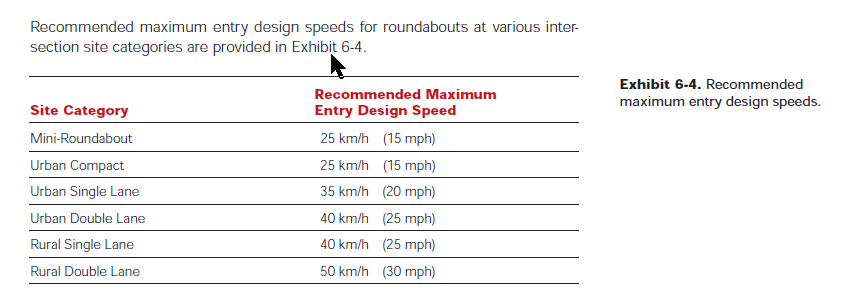
Currently, our
intersecting roads are classed as Rural
Single Lane roadways for all four of the intersecting roads. This results from the fact that the highway
speed limits for all four intersecting roads is 50mph which is exactly the
right speed limit for current road use and traffic AND that it actually IS a
rural highway. This results in the
designation of the desirable roundabout type as a Rural Single lane roundabout
with Maximum Entry speed of 25mph. The
existing ACS/LCG roundabout is DESIGNATED as 20mph entry speed limit, but (and
I gave it a try), it is a “hell of a left turn ride” if you try to make it at
20mph! About 11mph is comfortable and
allows you to stay off the overrun area, and 15mph is a reasonable maximum
using some overrun area. A lot of people will feel “very strained” if they go
through at 15mph. I suggest that any
reader give it a try himself! The entry
speed indicated by the speed sign supposedly will result in an uneventful trip
through a roundabout system. I have been told that Forsyth Engineering was not
INTENDING to build a roundabout to handle a 20mph entry speed maximum. My question is WHY NOT? If not, then WHY is this 20mph circulating
speed sign installed on this roundabout?
A roundabout or any other project should first be designed to ADEQUATELY
HANDLE existing vehicles types, configurations, and traffic levels using
existing highway approach speeds for the design. WHY was this not done is this particular case?
Minimum Roundabout Size
Second, Let’s consider what MINIMUM diameter the
DOT/FHA guide suggests for a roundabout system with a 25mph entry speed In the DOT/FHA guide, the following table
is presented.
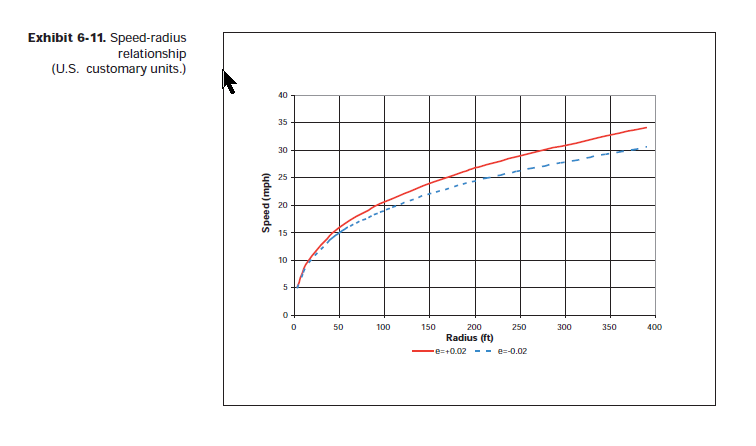
Let’s consider the
present design ACS/LC Roundabout system.
It has a design traverse radius for automobiles of about 29+(18/2)=38ft
radius.
(Note: This radius is the centerline radius of your car as it
rounds the roundabout. It is NOT the maximum radius of the
roundabout which in our case is about 43 ft.) From the above curve, it can be
seen that the DOT/FHA Guide RECOMMENDED maximum traverse speed is about
14mph! This for the Straight Through
path. This is just about the maximum
speed through the existing roundabout that feels reasonably comfortable. Now, let’s consider what size the Design
Guide tells us the roundabout SHOULD be for a traverse speed of 20mph as is
advertised by the existing ACS/LC Roundabout Signs. We can see that for even a 20mph traverse speed recommendation,
the traverse radius called for is about a 90ft car centerline radius and NOT the presently
available 38ft radius. HOW DID THIS
ERROR HAPPEN? And for a 25mph maximum
traverse speed, the radius would have been a radius of 170ft! This 170ft radius would make a rather large
footprint at this intersection and it is obvious why it was not selected. However, it is also obvious that our roundabout is
in the class of a Mini-Urban Roundabout and is basically NOT SUITABLE for its
present location and application. In
fact, what we have in the ACS/LCG roundabout is a City’s Roundabout for about a
30mph city street plunked down on a Rural 50mph Highway. WHY was this done? If we were going to put in a roundabout, something on the order
of the roundabout at the Dawson Forest/Lumpkin Campground intersection is what
would be a proper and reasonable design with growth potential for a (distant) future two lane roundabout.
I am going to switch
here to considering what the roundabout parameters would be for a roundabout with a
designed for 15mph Left Turn (R4) speed
and a 25mph straight through speed. A table of such values follows the image
below. NOTE that the radii below are
the turning radius of the vehicle and not the radius of the roundabout itself. 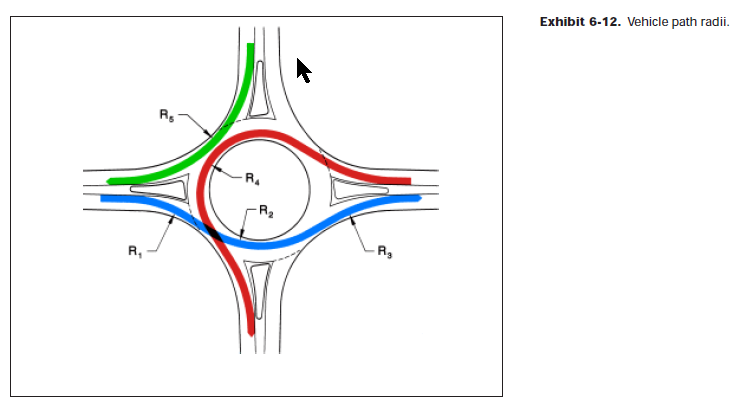

Note: The Inscribed Circle Diameter (m) should read Inscribed Circle Diameter (ft.)
This table shows that
for a R1 speed of 25 mph, the Inscribed Circle Diameter would be in the range of
100ft for the Urban Roundabout. Our Inscribed Circle Diameter is about 2x(29+14) = 86ft in
diameter. But
in such case, the R1 radius to achieve the desired 25mph straight
through speed would be 165ft on the straight through path.
Of course, there is absolutely no way to achieve this 165ft R1 radius
in our tiny roundabout. As a result, ALL traffic has to stay in
the approximate 37ft automobile centerline radius circle. This
gives us a traverse
speed for both R1 and R4 traffic of about 13mph! Where did anyone
come up with the suggestion that the ACS/LCG roundabout vehicle circle
speed maximum could be 20mph?! Thus, the existing roundabout
radius is only about 75 percent as large as it should be even for the
SMALLEST recommended RURAL roundabout. This does NOT take into
account the fact that
OUR roundabout is assymetrical and thus would normally be designed a
bit larger still to accommodate the non 90 degree apart roadway
situation. Again, the DOT guideline shows that the maximum circulating speed
(R4) is only 13mph and NOT the 20mph so optimistically assumed in our ACS/LCG
roundabout! Do we change the existing speed limit sign to 13mph?!
Think about this
question. Supposedly, this roundabout
is designed to be an URBAN roundabout suitable for traffic 10 to 20 years
ahead. If such a projection of the area
becoming urbanized were true, speed limits would likely come down, traffic
would dramatically increase and most likely a TWO-lane roundabout will be needed. What is going to happen then? This roundabout design is too small even for
present needs and cannot possibly be expanded to a two lane model within its
present footprint. If the county waits
to buy the additional needed land for 20 years, it will cost lots more that it
does now when the area is rural.
Additional right of way for a larger roundabout needs to be purchased
now if county projections are anywhere near accurate.
User Vehicle Size Accommodation
Now let us consider
user VEHICLES. Here is what the DOT/FHA Guide has to say about Vehicle types. 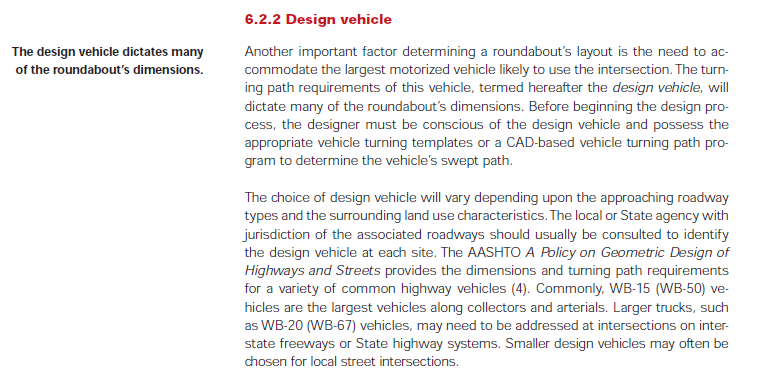
From time to time, I
see 32ft trucks with equipment trailers, long RVs, long School Buses and similar vehicles that TODAY want to use
this ACS/LCG Roundabout. Many drivers
tell me that now they have to drive way out of their way to avoid this cramped
roundabout design. WHY should they have
to do that? It seems like the first
order of business should be to design highway interchanges to reasonably accommodate
today’s users. Am I wrong here? WHY was the roundabout made so small that
larger vehicles would hit the curbs, have to pull trailers over the center
island and generally have an unmanageable traverse of the roundabout? Definitely, I am NOT talking about
tractor/trailer systems. Scuff marks on
all the curbs and ruts in the center island tell the story.
I personally suspect
that one of the reasons the roundabout was built to substandard size was to try
to prevent the use of the adjoining roadways by WB-15 and WB-50 vehicles. Bad Choice! A good design would not penalize
NORMAL traffic on every traverse of the roundabout simply to try and prevent
larger vehicle traffic. That is what NO
LARGE TRUCKS signs and police are for.
In fact, in years past, I have not seen but a very very small number of
Tractor Trailers come through and I suspect most of these were lost. :)
The Georgia DOT does
not have a comprehensive Roundabout Design Guide such as the USDOT/FHA
guide that I could find. But GDOT does have the following
to say about Design Vehicle types that applies to our situation.
“In addition to accommodating the design vehicle, Buses
(BUS-40) in urban areas and single-unit trucks (SU) in rural areas should be
accommodated within the circulatory roadway without tracking over the truck
apron.” See: www.dot.ga.gov/roundabouts. Our Roundabout also fails the above test.
Recommended Inscribed Circle Diameters for Various Applications
Let’s move on to the
Recommended Inscribed Circle Diameters recommended for various roundabout
types and locations.

I will note here that
the given values are for a Symmetric (all roads 90 degrees apart) Roundabout,
which the ACS/LCG roundabout certainly is NOT. So the recommended diameters are
SMALLER than actually needed in our case.
Our roundabout has an inscribed diameter of about 87ft. This is SMALLER even that the MINIMUM
recommended diameter of an RURAL SINGLE LANE roundabout which as shown above is 115ft. And if the roundabout was properly designed
for the 50mph RURAL intersection upon which it rests, the MINIMUM recommended diameter would be 115ft.
I realize that these DOT/FHA Guidelines are not “specifications”. In fact, Mr. Allen told me that this roundabout did not have to meet ANY specific highway specifications at all! My guess is that this was because this was a SPLOST project and not a joint State/Fed project. But we can all see what happens if the experiences of 100 years of roundabout building is casually ignored and a project totally out of place for its location, traffic mix and normal usage is built. We bought a cramped, difficult to transverse roundabout that no one is happy with. A quip here if I may. When I was at Lockheed, there was a remark I heard: An airplane not built to a standard design would look funny and probably would not fly very well. I think this is exactly the situation we have here. Our roundabout looks funny and does not work very well. This need not have happened.
Circulatory Roadway Width for Single Lane Roundabouts
The width of the
ACS/LCG roundabout's circular vehicle lane is very tight considering the very tight turning radius
of our ACS/LCG design. Let’s see what
the design guidelines say about this.
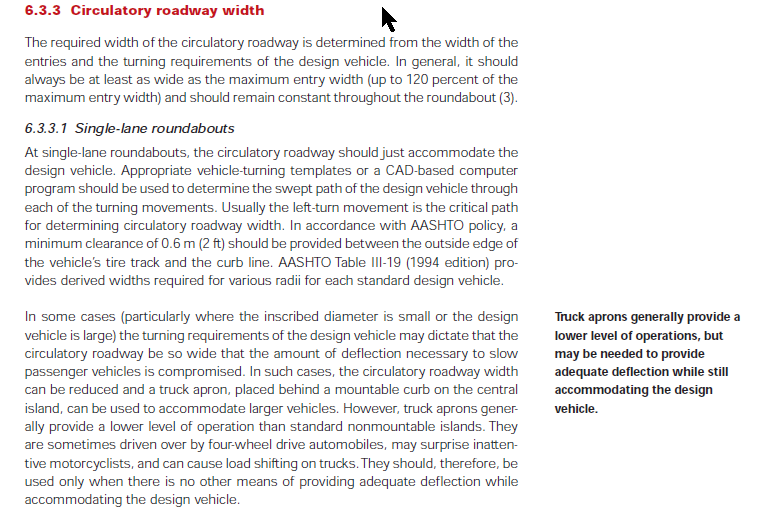
There are a number of points in the DOT/FHA guideline where our ACS/LCG is a very uncomfortable fit. While the MINIMUM width is supposed to be equal to the entry width of about 18ft or up to about 22ft for a STANDARD roundabout, our width (white line to center overrun area) gets down to just 17ft in part of the circle. This despite the fact that the outside white line is about 1ft from the curb instead of the recommended minimum of 2ft minimum, 3ft recommended. With the roundabout circle being this tight, other guides recommend the circulation width be 1.2 times the entry width and I agree. Our ACS/LCG model has all the bad features in the last paragraph as well. I could understand a few “boo-boos” on a first-of-kind construction. But in our case, this intersection is a pretty straightforward model. When I “Google” Rural Roundabout Design Guides, I see 1,340,000 articles. I have only consulted five of them, but, while the values DO vary, all of them show OUR design is too small for this NON-symmetric, RURAL Roundabout on a 50mph highway. What went wrong here?
Ladies and Gentlemen: The word
MINIMUM has a specific meaning. In all the situations above OUR
ACS/LCG roundabout is BELOW MINIMUM SIZE and very substantially
so! There is no wonder the roundabout does not function
well. I suggest that the Board Of Commissioners needs to
discover the WHY of Why did this design go to completion? Who was
watching? I was told by Pond Engineering that our roundabout
meets "all design requirements". I understand that the USDOT
"Design Guidelines" are NOT requirements. However, it you simply
ignore 100 years of collected design wisdom and proceed to "do your own
thing" and are not expert at your craft, you are quite likely to come
up with the North Forsyth Roundabout. Just a couple of
inexpensive Peer Design Reviews by a Roundabout Design Expert along the
way would have completely eliminated the problems we find in our new
roundabout!
Sidewalks
People are calling
the 250ft of sidewalks with wheelchair ramps “the sidewalk to nowhere”. In fact, I know of no other paved sidewalks
within about 3 miles. While seeing a pedestrian
is this area is not unheard of, it is rare.
Were these sidewalks essential?
Needed? Cost effective?
Desirable? I
am told that these sidewalks are REQUIRED by the US Government. I
guess we have to accept this as part of the "one size fits all" Federal
Government. :)
Simulators
In passing, I also
noted a very extensive array of available “Roundabout Simulators”. One that I watched a demo of put various
mixes of vehicles on a roundabout and showed how traffic flow varied with
roundabout design variations. I have
been successfully using computer simulation of electronic and mechanical
systems since 1968. I highly recommend
that someone associated with Roundabout Design at Forsyth County look into this
BEFORE another roundabout is contemplated!
Simulator use can demonstrate a great many potential problems that “seat of the pants guesswork” cannot dream
of.
NOT Rocket Science
Here is another point
I think is worth making. I am an Engineer, but I have never designed a
roundabout but I read fairly well. It took me
about one day to gather and understand information on the roundabout as it
exists. I spent another day reading
applicable sections of three roundabout guides and about 8 hours to assemble data and
write this document. What I am saying
here is: THIS KIND OF ANALYSIS IS EASY
FOR A QUALIFIED ENGINEER and Forsyth County should NEVER AGAIN proceed on such
as this without having a qualified Professional Engineer specializing in Roundabout Design do a cross check of
design features for a project against design guidelines! This will
a) save a lot of grief in the long run and b) will result in a better product
and c) taxpayers will get what they paid for.
I am hopeful that you accept this information in the constructive manner I intend. If the only result is to see that Forsyth County NEVER builds another IMPROPERLY DESIGNED FOR LOCATION ROUNDABOUT, then I will have done my job.
In every one of the above Roundabout Design Guide Criteria, the existing design is seriously undersized. No one should be surprised that motorists and taxpayers are frustrated about this roundabout.
1/12/2012 Update.
Thanks to the county for this week bringing the
signs around the roundabout into conformity with standard
guidelines. This was a needed safety measure.